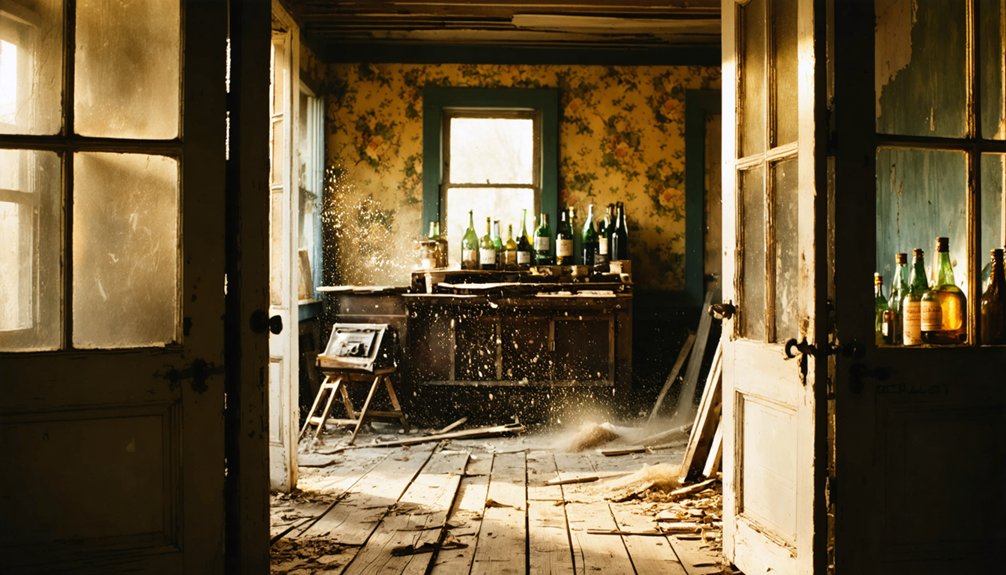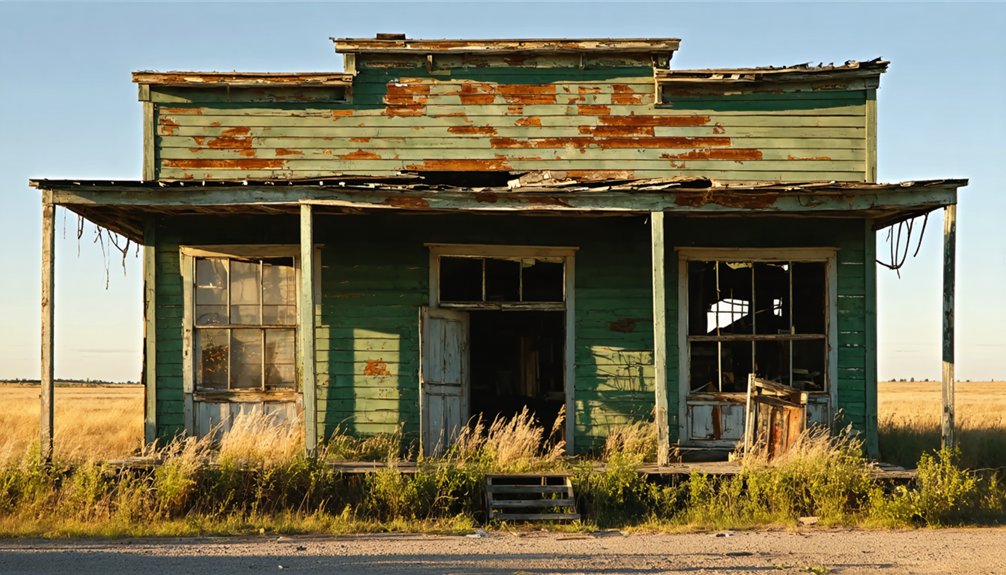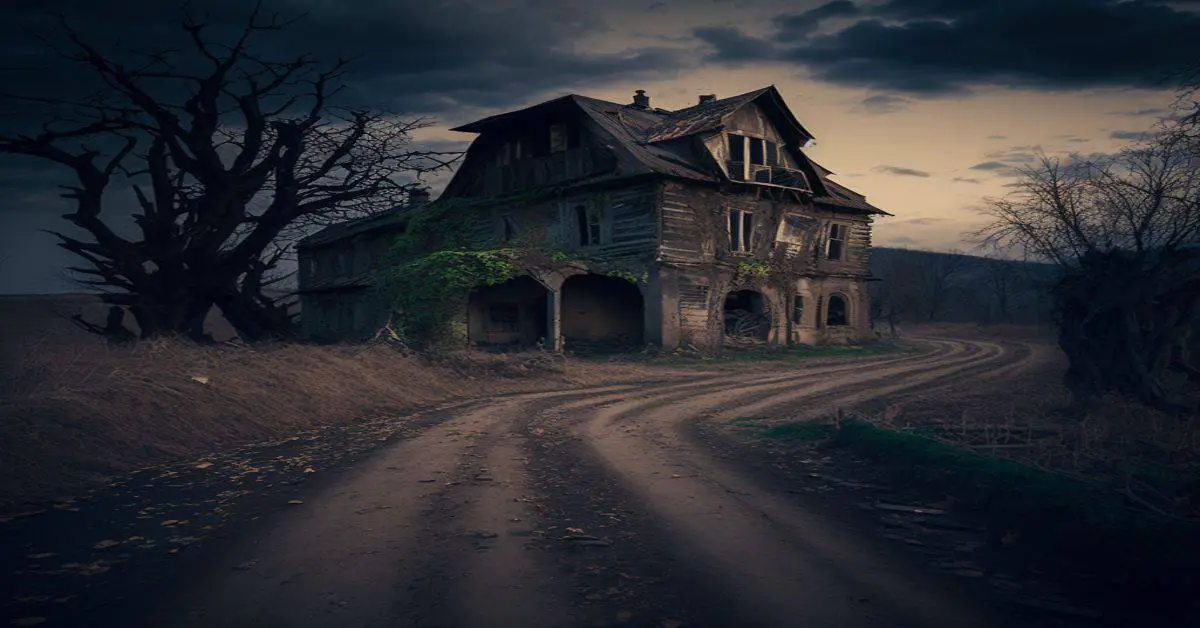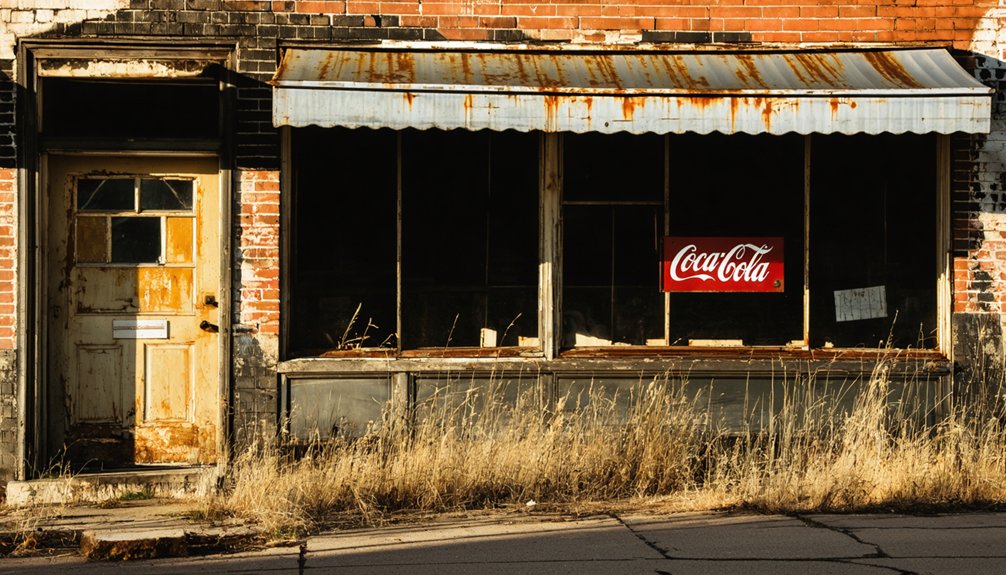You’ll discover Greenridge’s remains between Nilwood and Girard, Illinois, where a once-thriving coal mining town flourished from 1894 to the late 1920s. The town reached 325 residents at its peak, featuring 65 distinctive green houses and a diverse immigrant workforce, primarily Italian miners. After the mine’s closure in 1923 and declining railroad service, Greenridge transformed into a ghost town. Today, only faint roadbeds, abandoned tracks, and a single surviving house mark this lost community’s story.
Key Takeaways
- Greenridge was established in 1894 as a coal mining town between Nilwood and Girard, Illinois, with 65 distinctive green houses.
- The town reached its peak population of 325 residents, primarily miners and their families from Scotland, Wales, Italy, and Eastern Europe.
- Mine closure in 1923 and declining railroad service in the late 1920s led to rapid community abandonment and economic collapse.
- By 1939, most structures had disappeared, including the green company houses and railroad-dependent buildings, leaving only foundations.
- Today, only one house remains near the former downtown, with abandoned railroad tracks and overgrown farmland marking the town’s location.
The Rise of a Mining Community
Nestled between Nilwood and Girard, Illinois, Greenridge sprang to life in 1894 when a mining company constructed 65 distinctive green houses that would give the settlement its name.
You’ll find the mine positioned on Route #4’s east side, with most housing concentrated to the west, creating a typical late 19th-century coal town layout.
The community’s development reflected the broader expansion of Illinois mining, which had flourished since the early 1800s.
At its peak, the thriving community housed 325 residents, mostly comprised of miners and their families.
As the coal industry boomed, Greenridge’s labor dynamics drew diverse immigrant workers from across Europe.
You’d have encountered skilled miners from Scotland and Wales working alongside laborers from Italy and Eastern Europe.
The town’s strategic location along the railroad lines guaranteed steady coal shipments while facilitating the arrival of new workers seeking opportunity in America’s growing mining industry.
Workers faced grueling conditions, earning approximately 190 dollars for 179 days of ten-hour shifts in 1897.
Life Along the Railroad
While coal mining drove Greenridge’s economy, the railroad shaped every aspect of daily life in this bustling community of 300 residents.
You’d find railroad workers, from station agents to freight handlers, living alongside miners as they managed the constant flow of coal shipments and supplies. The tracks, which intersected with Illinois Route 4, dominated the town’s layout with nearly all businesses and homes positioned strategically around the rail line. An estimated 48 buildings stood west of the tracks, showing the town’s railroad-centric development.
Railroad life pulsed through Greenridge as workers and miners shared streets and homes near the tracks that defined their town.
Just like the Chicago & Iowa, which later became part of the CB&Q system, Greenridge’s railroad was vital to the region’s growth and development.
You couldn’t miss the hub of activity where freight transportation merged with passenger service on the electric interurban system connecting Springfield and St. Louis.
Telegraph operators kept communication flowing while grain elevators and stores clustered near the tracks served both locals and travelers.
When the railroad declined in the late 1920s, it spelled the beginning of the end for Greenridge’s vibrant community.
Italian Heritage and Social Fabric
Among the coal-mining families of Greenridge, Italian immigrants formed the heart of the community’s cultural identity. These families, primarily from southern Italy’s Abruzzo and Sicily regions, built strong social networks through their shared work in the mines and commitment to preserving their heritage.
You’d find their cultural identity expressed through Italian festivals that brought neighbors together, featuring traditional music, art, and cherished family recipes. Similar to Chicago’s Little Sicily, these communities maintained strong family ties despite economic hardships. The Concord Frates society provided community support, helping newcomers adjust while maintaining ties to their homeland.
Through their fraternal organizations, they’d gather to celebrate marriages, support each other during hardships, and preserve their customs. By 1930, Sangamon County’s Italians numbered 1,300 immigrants.
Even as Greenridge evolved, these Italian-American families maintained their close-knit relationships while gradually integrating into the broader American culture, leaving an indelible mark on the town’s social fabric.
Mining Operations and Daily Life
Deep beneath the Illinois prairie, Greenridge’s coal mining operations embodied the typical room-and-pillar techniques of early 20th-century extraction.
You’d find miners battling challenging geological conditions, including pyrite-laden coal and unstable shale roofs that required constant support from wooden props and cribs. The mining techniques they employed left pillars of coal standing to prevent catastrophic collapse, though surface subsidence remained an ongoing concern. Early settlers in the region began extracting coal from natural outcrops for local use. The Union Fuel #6 mine became the primary operation in the area.
Above ground, you’d see a tight-knit community of about 300 residents living in company-owned “green houses.”
Your daily life would’ve revolved around the mine’s schedule, with the railroad’s rhythm setting the pace for coal shipments and supply deliveries.
When mining operations ceased, you’d have witnessed the town’s rapid decline, as both people and buildings disappeared by the late 1920s.
Route 66 Era and Changes
As Route 66 emerged in late 1926, its initial alignment skirted Greenridge‘s eastern edge, running about a quarter mile from the declining mining town.
While you’d still see the highway’s impact on local activity, it wasn’t until 1930 that a major change occurred. That’s when officials realigned Route 66 to cut directly through Greenridge, creating what’s now Illinois State Highway 4.
This new path transformed the town’s geography, even requiring the removal of some buildings.
You might’ve witnessed modest commercial growth as automobile traffic increased, marking a shift from Greenridge’s railroad-dependent past.
The realignment reflected Illinois’ broader commitment to improving Route 66, which had already earned distinction as the first state to fully pave its entire segment of America’s most famous highway.
The roadway utilized mostly pre-existing roads to minimize construction costs and expedite the opening to traffic.
The Good Roads Movement of the late 1800s had laid the groundwork for these highway improvements, with bicyclists being the first to advocate for better road conditions.
The Town’s Final Days
Following the mine’s closure in 1923, you’d have witnessed the rapid exodus of Greenridge’s coal mining families as they sought work in surrounding towns with better rail connections.
You could track the town’s final decline through the railroad’s diminishing service, which effectively ended any remaining commercial possibilities for the few holdout residents.
Population Exodus Patterns
When the Green Ridge Mining Company ceased operations in 1923, the town of Greenridge entered a swift and irreversible population decline.
You’d have witnessed a distinct pattern as the demographic trends unfolded – mining families departed first, followed by merchants and service providers who’d lost their customer base.
The economic impacts rippled through the community as the town’s isolation, due to lack of railroad service, prevented any chance of recovery.
While some elderly residents and property owners lingered into the late 1920s, younger workers couldn’t wait – they quickly relocated to nearby towns with better prospects.
Within a decade, Greenridge’s transformation from a bustling mining community to a ghost town was complete, mirroring the fate of other single-industry towns across Illinois that couldn’t survive their economic foundations crumbling.
Railroad’s Final Departure
The railroad’s departure from Greenridge proved just as gradual as the town’s own decline, though its impact was no less devastating. The economic repercussions of railroad abandonment compounded the damage already inflicted by the mine’s closure in 1923.
You’ll find that as rail traffic dwindled through the late 1920s, trucking began to steal away what little freight business remained.
- The C&NW, IT, and GM&O lines that once bustled with coal shipments fell silent as regional shipping patterns shifted
- Local businesses, especially the grain elevator, struggled without reliable rail service
- The Illinois Terminal’s electric interurban service faded as improved highways drew traffic away
By 1939, you’d have seen nothing but foundations where railroad-dependent structures once stood.
Today, only Greenridge Road marks where this rail-connected community thrived.
Last Buildings Standing
As rail service vanished from Greenridge, its remaining buildings followed suit with startling speed. By the 1920s, you’d have found the green company houses already gone, leaving only scattered traces of the once-bustling mining community.
The last structures to survive included a single house near the former downtown and the post office, which closed its doors permanently in 1919.
Unlike other Route 66 ghost towns that maintained some visible presence, Greenridge’s community remnants quickly faded into farmland.
Today, you’ll find only faint roadbeds and subtle ground patterns along Green Ridge Road where buildings once stood. The abandoned railroad tracks mark the town’s western edge, while tree lines trace old boundaries – silent witnesses to a community that vanished almost completely before the century’s midpoint.
What Remains Today
Modern visitors to Greenridge, Illinois will find precious little evidence of this once-bustling mining community. The site, located about two miles north-northeast of Nilwood on Route 4, has been reclaimed by nature with vegetation covering what was once a thriving coal town.
Archaeological findings are limited, as no formal surveys have documented the area’s environmental impact or preserved its artifacts.
- Only one house remains near the former downtown area
- Abandoned railroad tracks cut through overgrown farmland
- Route 4 now runs directly over several former building sites
- No visible foundations or mining structures remain above ground
You’ll need prior knowledge to locate this ghost town, as there’s no signage marking its existence. The area is accessible via public roads, but the town center is indistinguishable from surrounding rural landscape.
Historical Significance and Legacy

Situated along Illinois’ coal-rich corridor, Greenridge exemplifies the boom-and-bust cycle that shaped early 20th-century mining communities.
You’ll find its story deeply woven into the fabric of industrial shifts that transformed rural Illinois, from the rise of coal mining to the dawn of the automotive age.
The town’s cultural resilience shines through its diverse immigrant heritage, particularly its Italian-American mining leadership.
While the physical structures have vanished, Greenridge’s legacy lives on through historical documentation, Route 66 research, and academic studies.
You’ll discover its importance as a case study for understanding how railroad-dependent communities adapted – or didn’t – to changing economic conditions.
Today, scholars and enthusiasts continue to explore Greenridge’s story, preserving essential lessons about single-industry towns and their vulnerability to market forces.
Frequently Asked Questions
Were There Any Notable Crimes or Incidents During Greenridge’s Peak Years?
You’ll find absolutely zero unsolved mysteries in this million-dollar ghost town – historical records don’t reveal any notable crime history during Greenridge’s peak years as a bustling mining community.
What Happened to the Residents’ Graves and Cemetery After Abandonment?
You won’t find clear records of grave relocation or cemetery preservation efforts – there’s no confirmed evidence a formal cemetery existed, and any potential unmarked graves were likely lost to agricultural development.
Did Any Famous People or Celebrities Ever Visit Greenridge?
Like trying to find a viral TikTok from 1920, there aren’t any documented celebrity sightings in the town. You’ll only find historical significance through the everyday coal miners who worked there.
What Was the Maximum Population of Greenridge During Its Prime?
During its peak when coal mining and railroad transportation drove Greenridge’s economy, the town reached a maximum population of 300 residents, supporting about 65 houses and local businesses.
Were There Any Schools or Churches Built in Greenridge?
You won’t find documented school architecture or church history records for this location. While informal education and worship likely occurred in homes or shared spaces, no confirmed permanent structures were built.
References
- https://www.youtube.com/watch?v=dV1Q41xepBA
- https://drloihjournal.blogspot.com/2022/09/lost-towns-of-illinois-greenridge-illinois.html
- https://www.youtube.com/watch?v=gM3ZIgtFzBk
- https://www.youtube.com/watch?v=ZxZhuzNkxE8
- https://drloihjournal.blogspot.com/search/label/Lost Towns of Illinois
- https://storymaps.arcgis.com/stories/043201d4267e4a66b44e7922832df7a2
- https://en.wikipedia.org/wiki/List_of_ghost_towns_in_Illinois
- http://www.illinoisarchaeology.com/IDNR/Coal Mines/Interstate Coal Company Mine ASSR 2.pdf
- https://wikiimage.isgs.illinois.edu/ilmines/webfiles/topo-mines/centralia-east.pdf
- http://www.illinoislaborhistory.org/labor-history-articles/mine-union-radicalism-in-macoupin-and-montgomery-counties-il



